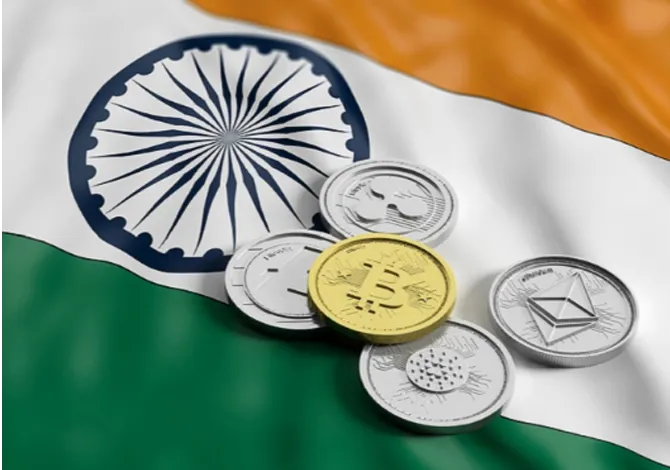
India's leading position in grassroots cryptocurrency adoption signals a remarkable trend in the global landscape. While the worldwide pattern indicates a decrease in grassroots crypto adoption, lower middle-income (LMI) countries present a noteworthy exception. India's embrace of cryptocurrencies, especially among the youth, is notable, particularly given its status as home to the world's largest population of young people. Despite the lack of regulatory clarity and hurdles to investments within the cryptocurrency ecosystem, India, with its thriving startup ecosystem and growing smartphone and internet penetration, has the potential to position itself as a future crypto hub.
India's embrace of cryptocurrencies, especially among the youth, is notable, particularly given its status as home to the world's largest population of young people.
Crypto on the rise
Asia is at the forefront of cryptocurrency adoption, with India, Vietnam, the Philippines, Indonesia, Pakistan, and Thailand securing positions in the top 10 for crypto adoption. Grassroots crypto adoption is not determined by which countries have the highest raw transaction volumes. Instead, the focus is on highlighting the countries where crypto is embraced the most by average, everyday people. There are varied and unique reasons for the growth of crypto in these countries. One way to look at it is that the growth of cryptocurrency within a nation is intricately tied to its unique economic conditions. Take Pakistan, for example; economic challenges in the country mean that savings are susceptible to rapid erosion. Moreover, there are limited investment options available for the general populace in the current economic climate. The equities market and stock exchange have declined, and any financial gains are susceptible to being offset by inflation. This nuanced interplay between economic conditions and cryptocurrency adoption underscores the diverse factors influencing the crypto landscape across Asia, and not just Pakistan.
Vietnam has a different set of circumstances that promote the growth of cryptocurrency. Cryptocurrency's success in Vietnam stems from limited legislation for citizens and historic skepticism towards the national currency. The absence of formal regulation, while advantageous, presents challenges with no legal recourse. The large unbanked population, constituting nearly 69 percent of Vietnam, embraces crypto for financial services, making decentralised finance (DeFi) usage one of the world's highest.
India, while showcasing growth, is not without its challenges; certain aspects demand attention, rectification, and a deeper understanding. The Indian GDP hit the US$3.7 trillion mark and is one of the fastest-growing economies in the world. It has a developed equities market and stock exchange, unlike Pakistan, and strong regulations and a steadily decreasing unbanked population, unlike Vietnam. The growth of crypto in India could potentially be influenced by the demographic dividend, along with the rising rates of internet and smartphone penetration.
The growth of crypto in India could potentially be influenced by the demographic dividend, along with the rising rates of internet and smartphone penetration.
India’s crypto landscape
GenZ dominates the crypto landscape in India with a 45 percent user share, followed by 35 percent in the 26-35 age group and 13 percent in the 36-45 range. Surprisingly, nearly 8 percent of crypto users are from the baby boomer generation. Delhi takes the lead in crypto adoption in terms of investment value in India, trailed by tech hubs Bangalore and Hyderabad. Among tier-2 and tier-3 cities, Jaipur emerges as the top contender for crypto adoption, with Lucknow and Pune following suit. These insights are drawn from data provided by CoinSwitch users only, which do not represent the complete Indian crypto ecosystem. However, they offer valuable anecdotal perspectives for understanding and analysing the Indian crypto landscape.
Reflecting on the impressive growth figures in crypto, it becomes imperative to present a more nuanced and accurate portrayal of the ecosystem. In 2021, the crypto landscape saw a surge in investments. A noteworthy US$513 million was injected by investors into 32 crypto deals, with a significant milestone achieved as unicorn status was secured by CoinDCX through a US$90 million funding round in August 2021.
However, the trajectory took a turn in 2022 amid a global economic landscape shaped by the Russia-Ukraine war, inflation, and regulatory uncertainties. This period dubbed the "funding winter," brought forth challenges for all startups. These challenges encompassed the sharp decline in cryptocurrency prices, collapses and controversies at major exchanges, and regulatory ambiguities. Collectively, these factors created a formidable environment for crypto startups, necessitating their adept navigation of a market undergoing a profound shift in sentiment. Nevertheless, India stands as the top global adopter of cryptocurrency despite such conditions.
Regulatory Crossroads
India's emergence as a prominent cryptocurrency market is notable, given the complex regulatory and tax environment. In the past year, regulatory bodies have provided clarity on various issues, including the application of anti-money laundering rules to cryptocurrency transactions. India imposes a considerably higher tax rate on cryptocurrency activities compared to most countries, with a 30 percent tax on gains, surpassing rates for other investments like equities. Additionally, there's a 1 percent tax on all transactions, known as tax deducted at source (TDS), requiring crypto platforms to deduct this amount for every trade. The uneven implementation of TDS, particularly by international exchanges, might impact the competitiveness of homegrown Indian exchanges. Millions of Indian users shifted to offshore platforms following the introduction of TDS, with a single offshore platform reporting over 450,000 user signups in the month following its implementation. The inconsistency in collecting TDS taxes could be attracting Indian users to international platforms, evident in the surge of web traffic to these exchanges after the introduction of TDS in July 2022.
Horizons of crypto in India
India's adoption of cryptocurrencies, particularly among the youth, stands out as noteworthy. This becomes even more intriguing considering India boasts the largest youth and adolescent population globally. Despite recent challenges in terms of regulations and investments within the cryptocurrency ecosystem, India, with its robust startup environment and increasing smartphone and internet penetration, holds the potential to emerge as a future crypto hub. This prospect warrants a more in-depth analysis, prompting several pertinent questions: How will this growth align with India's central bank digital currency (CBDC)? What long-term effects might India's crypto tax policy have on the ecosystem? Is it plausible to envision a crypto-native population, given the scale and early adoption of these technologies? Examining these elements will offer an in-depth comprehension of India's dynamic role in the global cryptocurrency landscape. India's demographic dividend appears pivotal not only in shaping the nation's global and domestic aspirations but also in influencing the constantly evolving landscape of cryptocurrency.
Sauradeep Bag is an Associate Fellow at the Observer Research Foundation.
The views expressed above belong to the author(s). ORF research and analyses now available on Telegram! Click here to access our curated content — blogs, longforms and interviews.




 PREV
PREV


